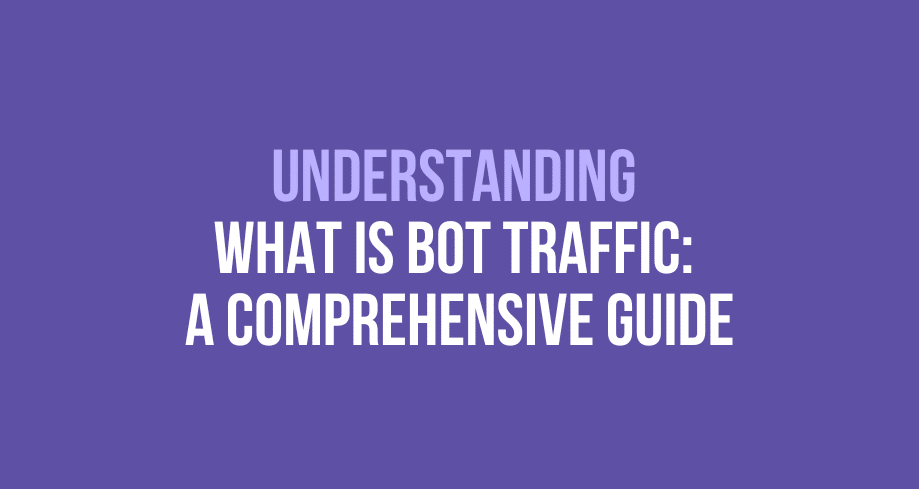Website owners and marketers face a constant challenge: bot traffic. But what is bot traffic and why is it important to understand?
By the end of this guide, you’ll have a solid understanding of bot traffic and its significance in the world of SEO. So, let’s dive in and unravel the mysteries of bot traffic to safeguard your website’s performance, protect your data, and optimize your digital presence.
What is Bot Traffic?
Bot traffic refers to the automated web requests that are generated by software applications known as bots. These bots perform various tasks on the internet, ranging from indexing web pages for search engines to collecting data and performing automated actions. Understanding bot traffic is essential for website owners and marketers as it impacts website performance, analytics, and overall online strategy.
Bots serve different purposes depending on their design and function.
Common Sources of Bot Traffic
Bot traffic can originate from various sources, both legitimate and malicious. Understanding these sources is essential for identifying and managing bot traffic effectively. Here are the major sources of bot traffic:
Search Engine Crawlers
Search engines like Google, Bing, and Yahoo employ bots known as search engine crawlers or spiders. These bots crawl websites across the internet, following links and indexing web pages. Googlebot and Bingbot are examples of well-known search engine crawlers. Their purpose is to gather information about web pages, analyze content, and rank them in search engine results.
Social Media Bots
Social media platforms also utilize bots for specific functions. For instance, Facebook has a bot called Facebot, which scans web pages shared on the platform to generate previews with images, titles, and descriptions. Twitter uses its Twitterbot to collect website information for link previews. These bots ensure that shared links display accurate and visually appealing previews on social media.
Content Scrapers
Content scraper bots are malicious bots that scrape or extract content from websites without permission. They gather website content, including text, images, and other media, and may use it for various purposes, such as creating duplicate websites or publishing stolen content elsewhere. Content scraping can negatively impact original website owners by diluting search engine rankings and duplicating content.
Spam Bots
Spam bots are designed to generate spam messages or comments on websites, forums, or blogs. They aim to spread irrelevant or promotional content, often containing links to malicious websites or phishing scams. Spam bots can overwhelm comment sections, disrupt conversations, and degrade the user experience.
Click Bots
Click bots are malicious bots that artificially inflate website traffic or ad impressions. They simulate user interactions by generating fraudulent clicks on ads, resulting in inflated statistics and potentially wasting advertising budgets. Click bots can manipulate click-through rates (CTRs) and affect the accuracy of analytics data, making it challenging to measure real user engagement.
How Bot Traffic Affects Websites
Bot traffic can have several effects on website performance and user experience. Understanding these impacts is crucial for website owners and marketers to effectively manage and optimize their online presence. Here are the key ways in which bot traffic can affect websites:
Increased Server Load and Bandwidth Consumption: Bot traffic can put a strain on servers by generating numerous automated requests. This increased server load can result in slower response times, website crashes, or even server overload. Additionally, bots consume bandwidth as they access website resources, potentially affecting website performance for genuine human visitors.
Skewed Analytics Data: Bot traffic can distort website analytics by artificially inflating visitor counts, page views, and other metrics. This can lead to inaccurate data interpretation, making it challenging to gauge the true engagement and behavior of human visitors. Skewed analytics data can misguide marketing strategies, hinder decision-making, and impede accurate performance analysis.
Importance of Distinguishing Between Bot Traffic and Genuine Human Visitors: It is crucial to differentiate between bot traffic and genuine human visitors to accurately analyze website performance and optimize user experiences. By identifying and categorizing bot traffic, website owners can filter out irrelevant data from analytics reports, ensuring that decisions and strategies are based on accurate information. Distinguishing between bots and humans also enables the implementation of targeted measures to manage and mitigate the negative impact of bots, such as implementing CAPTCHAs, IP blocking, or utilizing bot detection services.
Identifying Bot Traffic
Several methods and tools are available to help website owners and marketers in this process. Here are some common approaches to detect bot traffic:
Analyzing Server Logs: Analyzing server logs provides valuable insights into the requests made to a website. By examining IP addresses, user agents, and other log data, website owners can identify patterns indicative of bot activity. Unusually high request rates from specific IP addresses or user agents may suggest the presence of bots.
Implementing CAPTCHAs: CAPTCHAs (Completely Automated Public Turing test to tell Computers and Humans Apart) are widely used to distinguish between humans and bots. By implementing CAPTCHAs on forms, login pages, or other website areas, website owners can verify that a user is human before allowing access. CAPTCHAs typically present challenges that are difficult for bots to solve but easy for humans to complete.
Using Bot Detection Services: Bot detection services provide specialized tools and algorithms to identify and mitigate bot traffic. These services leverage machine learning and behavioral analysis to detect patterns and characteristics of bot activity. They often provide real-time monitoring, allowing website owners to receive alerts and take immediate action against suspicious or malicious bot traffic.
Monitoring Web Traffic Patterns and Identifying Suspicious Activity: Regularly monitoring internet traffic patterns is essential for identifying suspicious activity that may indicate bot traffic. Sudden spikes in traffic, unusual browsing patterns, or repetitive requests from specific IP addresses can be red flags. Monitoring website analytics and conducting periodic audits of web traffic data can help uncover abnormal patterns and identify potential bot activity.
Importance of Vigilance and Proactive Measures: Maintaining ongoing vigilance and proactively implementing measures to mitigate the risks associated with bot traffic is vital. Bots are continuously evolving, and new bot types and tactics emerge regularly. By staying informed about the latest bot trends and adopting proactive measures, such as updating software, implementing security plugins, and keeping security measures up to date, website owners can effectively protect their websites from malicious bots and minimize their impact.
Preventing and Managing Bot Traffic
Here are actionable tips to help website owners and marketers effectively prevent and manage bot traffic:
Implement a robots.txt File: Utilize a robots.txt file to communicate with search engine crawlers and instruct them on which parts of your website they can and cannot access.
Set up IP Blocking: Identify IP addresses associated with malicious bots or suspicious activities and block them from accessing your website. IP blocking can be done through server configurations, firewall rules, or security plugins that provide IP-blocking functionality.
Use Web Application Firewalls (WAF): Implement a firewall to protect your website from bot traffic. A WAF filters incoming web traffic and can detect and block suspicious bot activities based on predefined security rules and patterns.
Regularly Update Software: Keep your website software, including content management systems (CMS), plugins, and themes, up to date. Frequent updates typically consist of security patches designed to address vulnerabilities and protect against well-known bot attacks.
Employ Strong Authentication Measures: Implement robust authentication measures, such as strong passwords, multi-factor authentication (MFA), and CAPTCHAs, to ensure that only genuine users can access sensitive areas of your website. Additionally, consider installing and regularly updating reputable antivirus software, like Bitdefender Antivirus for added defense against malicious bots.
Use Proactive Security Plugins: Install security plugins specifically designed to detect and mitigate bot traffic. These plugins can offer bot detection, CAPTCHA integration, IP blocking, and real-time monitoring to protect your website from bot-related threats.
Emphasize Regular Monitoring, Analysis, and Optimization: Monitor your website’s traffic patterns, visitor behavior, and analytics data to identify any unusual or suspicious activity that may indicate bot traffic. Regularly analyze this data to understand trends, patterns, and potential vulnerabilities. Optimize your security measures and bot management strategies based on the insights gained from monitoring and analysis.
Bot Traffic and SEO
Bot traffic can have positive and negative implications for search engine optimization (SEO) efforts. Here’s how bot traffic can affect SEO:
Impact on SEO Efforts
Good bot traffic, which includes search engine crawlers, can positively contribute to SEO efforts by indexing web pages, making them discoverable to users, and improving organic visibility. On the other hand, bad bot traffic can negatively affect SEO efforts by skewing analytics data, leading to inaccurate performance analysis and decision-making.
Benefits of Good Bot Traffic
Good bot traffic, primarily search engine crawlers, plays a crucial role in SEO. When search engine crawlers index web pages, search engines can understand and rank the content for relevant search queries. The more efficiently and thoroughly search engine crawlers can access and index your website, the better your chances of achieving higher organic rankings and visibility in search engine results.
Preventing Bad Bot Traffic
Bad bot traffic, such as scraper bots or click bots, can distort website analytics, generate spammy backlinks, or engage in other activities that violate search engine guidelines. Search engines like Google and Bing penalize websites that engage in manipulative or fraudulent practices, which can lead to decreased organic rankings or even removal from search engine results. Preventing bad bot traffic helps maintain accurate analytics data, avoids penalties, and ensures a positive SEO performance.
To effectively manage bot traffic for SEO purposes, website owners and marketers should implement preventive measures such as CAPTCHAs, IP blocking, and bot detection services. By differentiating between good and bad bot traffic, optimizing website accessibility for search engine crawlers, and preventing malicious activities, website owners can safeguard their SEO efforts, maintain accurate analytics, and comply with search engine guidelines.
Frequently Asked Questions
How can I identify bot traffic on my website?
There are several methods to identify bot traffic. You can analyze server logs for unusual patterns, monitor IP addresses for suspicious activity, utilize bot detection services, or implement CAPTCHAs to filter out automated requests.
What is the impact of bot traffic on website performance?
Bot traffic can increase server load, consume bandwidth, and result in slower loading times or unresponsive pages. It may also distort analytics data, making it challenging to analyze website performance accurately.
How can I prevent bad bot traffic from accessing my website?
Implementing measures such as IP blocking, web application firewalls (WAF), and security plugins can help prevent bad bot traffic. Regularly updating software, employing strong authentication measures, and implementing CAPTCHAs are effective preventive measures.
Conclusion
Bot traffic plays a significant role in the digital landscape, and understanding its impact is crucial for website owners and marketers. Throughout this blog post, we explored the concept of bot traffic, its sources, and its effects on websites. We discussed the distinction between good bots, such as search engine crawlers, and bad bots, including malicious ones, like spam or scraper bots.
Now it’s time to take action. Implement the recommended strategies to manage bot traffic and protect your website effectively. Doing so will optimize website performance, enhance user experience, and safeguard your online presence against the risks associated with bot traffic.




